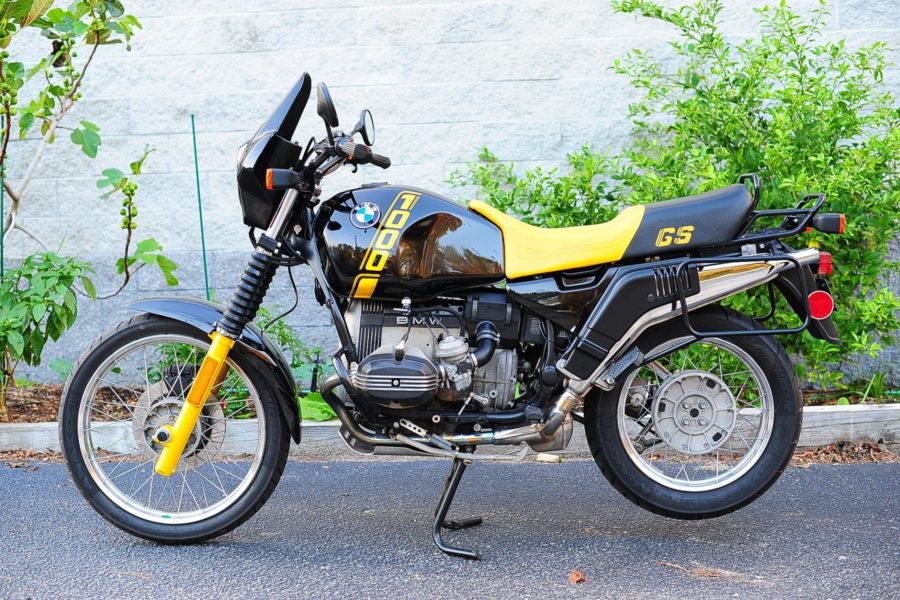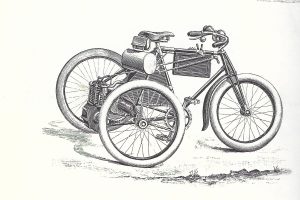一些马赫ines are classics, not just in their category, but of the whole motorcycling scene. The Norton Commando, the original Suzuki Katana, the Yamaha XS650, the Kawasaki GPZ900. And, you could include the BMW R100 GS in that list.
It’s been 25 years since the R100 GS ceased production, and they’re harder to find in good condition these days. Lucky you, then—there’s a gorgeous example from 1989 for sale onBring A Trailer, in the much-coveted Bumblebee colours.

The stock charging system was swapped out for an aftermarket unit.
Maximum Airhead
Introduced for 1987, the R100 series was BMW’s final airhead GS—although, as you can see by the photos, it actually came with an oil cooler. Like the original R80 G/S, the R100 GS had a boxer twin engine, with two-valve heads, shaft drive and five-speed gearbox, derived from the era’s street bike engines. The GS had lower compression than BMW’s asphalt-only versions of the machine (R100 RS, etc.), to run on lower-quality gasoline in remote areas. Still, many owners went to a dual spark plug setup, to improve ignition and fuel economy. It made around 60 horsepower at 6,500 rpm.
Opinions are varied on the old airhead’s usability. Some people love the R100 GS for its simplicity and lack of electronics (carburetors instead of EFI, and certainly no engine riding modes or anything like that to worry about!). Because it was an airhead engine, riders could tune it up for more speed with parts off other R100-series bikes, although the added performance sometimes came at the cost of reliability.

Low mileage, for an ’89 model!
Other riders prefer the reliability and smoothness of the oilhead engines that replaced the R100 line, with fuel injection and other moves towards modernity. There’s no right or wrong answer here, but the general consensus is thatif you want an airhead GS, the R100 is as good as it gets. As long as you kept up maintenance, these engines would power you around the world multiple times. There’s a reason they’re much-loved in the Euro ADV bike scene, even to this day; many of the famous round-the-world travelers from the 1980s and 1990s used these bikes on their journeys, and still ride them to this day. If your driveshaft holds together, the rest of the bike is all fixable. There’s evenstrong aftermarket supportstill.
Although today’s machines would have finer-tuned suspension and chassis, the R100 has nothing to be embarrassed about. Curb weight for this bike was about 520 pounds, compared to about 550 pounds for the R1250 GS (although the R1250 does have 136 horsepower—it’s got more weight, buta lotmore muscle). As for running gear; the GS came with 21-inch front wheel and 17-inch rear, as a proper adventure bike should, a front disc brake, and a drum brake in rear. The rear shock had a progressive damping system, with direct attachment to the single-sided swingarm. Up front, the GS used telescopic forks, unlike newer models with the Telelever front end. BMW kept things simple on this bike.

Everything is shiny and appears to be well looked-after.
A clean machine
The thing with adventure bikes is, they tend to live a hard life. Even the ones that only get ridden to Starbucks—sooner or later, someone else buys that bike from the original latte-sipping owner, and promptly drops it while riding down a dirt road. It’s the way of the jungle. For that reason, it’s hard to find a truly clean vintage GS, especially one from 1989, unless you buy one that’s been restored.
That’s what makesthis particular bikea rare beast. It’s a true survivor, with no real mangled parts, but (it seems) no professional restoration. The odometer reads 16,844 miles, and it looks like it saw fastidious care through that riding. The seller bought it off the original owner earlier in 2020, and is now moving it on.

Factory BMW luggage comes with the deal.
Most of the original bits seem to be there (no handguards, though), with few aftermarket bits. There’s a set of BMW factory plastic panniers, with mounting racks. That aluminum skid plate is a BMW factory accessory, not a third-party item. The charging system was upgraded to a EnDuraLast 450-watt unit, which is probably wise for a bike of this age. The seller even has the factory tire repair kit and toolkit, which is unthinkable on most bikes more than 30 years old. This sort of maniacal devotion to maintenance and propriety isexactly what you’re looking forwhen buying any used vehicle, especially a used motorcycle.
There’s a cold-start video of the GS below, and a riding video below that:
From the photos, the bike looks super-sano, and it comes in the highly desirable Bumblebee paint scheme. BMW revived this yellow/black paint for its 40th anniversary models, because GSphiles like it so much.
Now, the GS experts on this forum (of which there are many,hereorhere)可能会发现各种各样的这辆自行车的毛病,但是from an arm’s length viewpoint, I only see one problem: I can’t afford it. Vintage GSs are getting more and more expensive all the time. Soon, machines like this will only be realistically affordable for the truly well-heeled.







